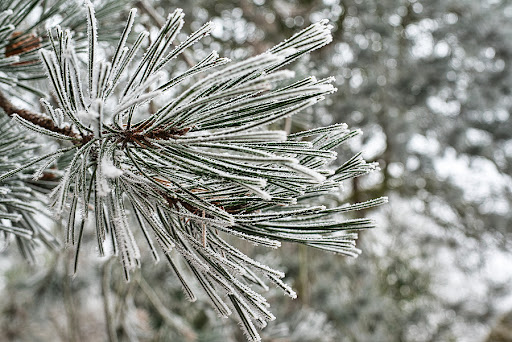 When the cold winter months arrive, your garden doesn’t have to become a dull, lifeless space. With a few simple additions, you can transform it into a winter wonderland and enjoy the outdoors even during the colder months. Here are some tips on adding winter interest to your garden and keeping your space looking beautiful all year round.
When the cold winter months arrive, your garden doesn’t have to become a dull, lifeless space. With a few simple additions, you can transform it into a winter wonderland and enjoy the outdoors even during the colder months. Here are some tips on adding winter interest to your garden and keeping your space looking beautiful all year round.
Plant evergreens
One of the easiest and most effective ways to add winter garden interest is planting evergreen shrubs. Evergreens are versatile and can be used to create privacy or as an anchor for flower beds and other garden areas. Evergreens come in various shapes, sizes, and colors, making them perfect for adding texture and color to your garden, even in the coldest months of the year. Planting evergreens also provide shelter and food for wildlife in the winter. Species that can provide year-round interest include boxwood, holly, juniper, pine, and spruce.
Incorporate different textures
Texture is an important element to consider when creating a winter garden. Adding various textures can help to create interest and dimension in the garden, even during the coldest months of the year. Start by planting a few evergreens. Pine, fir, juniper, and holly are nice options. They will add structure and texture to your garden. Grasses and ornamental grasses are also great for adding texture, especially when covered in a layer of frost or snow. When choosing plants, select those with interesting foliage or textured bark.
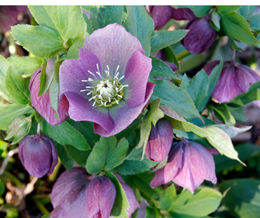 Use winter-blooming flowers
Use winter-blooming flowers
Bring life to your garden with winter-blooming flowers! While many plants go dormant during the colder months, some will bring color to your garden. Consider planting pansies, violas, and primroses for a burst of vibrant color. Or opt for hellebores or winter daphne for more subtle blooms.
Winter Container Gardening
Cheerful winter pots outdoors can help brighten up and decorate your yard. Make sure your vessels can survive fluctuating temperatures. Porous materials like ceramic and terracotta are subject to flaking and can crack in freezing temperatures.
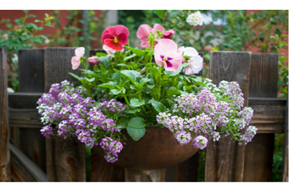 Best Types of Planters
Best Types of Planters
Planters made of metal, fiberglass, heavy-duty plastic, or wood are the least likely to crack during freezing temperatures. If you have stone, cement, or concrete planters outside, make sure they have drainage holes so water doesn’t get trapped to freeze and thaw, causing damage to them.
Ideas for Winter Containers Include:
- Juniper
- Rosemary
- Grasses
- Boxwood
- Sedum
- Coral Bells
- Ornamental Cabbage
Plant Berries
Berries are a great way to add winter interest to your garden! Not only do they provide a vibrant burst of color, but they also attract wildlife, such as birds.
- Winterberry has beautiful red berries that can stay on the plant throughout the season, providing beautiful contrast against the snow.
- Beautyberry produces clusters of purple berries that can provide a dramatic display in winter.
- Pyracantha is another great option, as it bears clusters of bright yellow or orange berries throughout the winter
- Japanese Skimmia is an evergreen shrub that has red berries that remain in winter and white flowers in late spring.
Add Lighting
Lighting can be used to create a cozy and inviting atmosphere in your garden during the winter months. Solar-powered garden lights are a great option for those who want to conserve energy, and LED lights are very energy-efficient and long-lasting. No matter what type of lighting you choose, it will add a unique touch to your garden and make it look even more beautiful during winter.
Let us know how we can help with winter gardening for your landscape, give us a call at 360-574-8979.
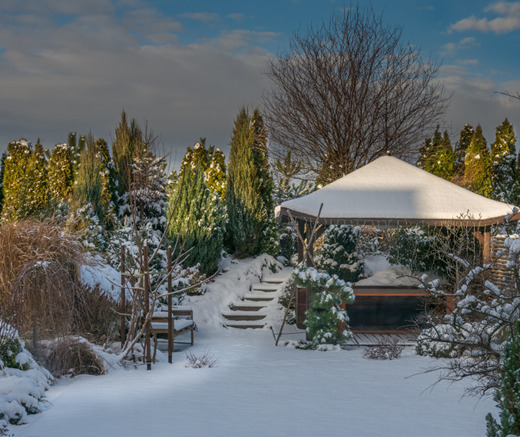
Winter is such a beautiful time of year, and it’s not all cold and snowy. It’s also an amazing time to enjoy the wildlife in our area. Whether you want to make your backyard a winter haven for birds or hibernating insects, there are many ways that you can add plants and food for winter wildlife interest.
Plant Evergreens
One of the best ways to provide natural shelter in the winter garden is by planting an evergreen hedge or tree. These plants will provide cover from predators and allow animals to nest underneath them if they choose. In addition, evergreens will block out wind and provide heat when needed during colder months, as well as shade on warmer days.
 Incorporate Plants with Seeds and Berries
Incorporate Plants with Seeds and Berries
Some plants have seeds that stay on the plant through winter, so if you have a garden, consider leaving any remaining plants that have seeds. You can also use perennial plants as a natural way to attract wildlife in your yard. Tall weeds like milkweed and amaranth provide important habitats for monarch butterflies and other pollinators. And bushes like huckleberry, blueberry, and rose hips provide food for birds and mammals during winter months.
Leave Some Areas for Shelter
Don’t bag up all your leaves; spread them on the flower beds; it’s good for your soil and provides shelter for frogs and insects. Leave some pots and piles of bricks lying around for frogs. Make or buy some bug hotels and other insects such as lacewings and ladybugs, or just drill some holes in a log! Build nesting boxes with an entrance hole big enough for an animal to enter and exit easily. In colder climates with snow cover, pile snow near plants to insulate them from cold air. If you have a compost heap, place hay bales on top of it so that animals can find food and cover.
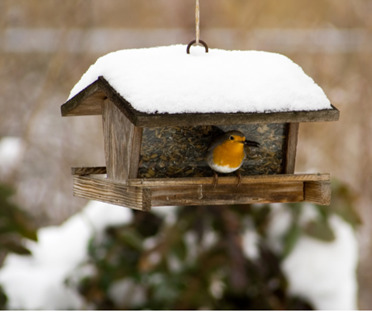 Feed Birds
Feed Birds
Attract birds by providing feeders filled with seeds and suet during the colder months. Be sure to keep the feeders clean by regularly sterilizing them. Bird feeders are busy in the winter and can spread disease.
Offer Water in Winter
Birds need water year-round, but in winter, it becomes more important for their survival. Even if the ground is frozen, there are ways to provide water for birds. Placing bird baths near windows or feeding stations will allow the birds to get close enough to drink from the bath.
For help with the design and maintenance of your winter landscape, give us a call at 360-574-8979.

Winter preparations need to be made for all aspects of your landscape, including your water features. Taking the time to protect your fountain or other outdoor water features from the risk of damage from water and freezing temperatures will protect your investment.
Size matters
If a water feature is large enough, it may be best to keep it running all year. This may be a necessity for water features containing fish. If you have a pond with fish, check during the winter to make sure there is a space for them to get oxygen if the water freezes over. To do this, you can get a de-icer that floats or aim the pump toward the surface to create an open area for the fish to breathe.
For smaller water features, it is easiest to drain and properly protect it for the season. Otherwise, water can settle, freeze, and expand, causing cracks or damage to your water feature.
Follow these simple steps to winterize your outdoor water feature:
- Empty the water from the water feature and make sure the pump is fully drained.
- Store the pump in a dry location like a garage or shed.
- Remove any leaves or debris.
- Use a cleaner such as Simple Green and scrub to remove dirt and algae.
- Dry it out with sponges or towels, or let it air dry.
- Remove any pieces that are unsteady or at risk of toppling over in the snow or wind.
- Get or make a cover for your water feature. Ideas include using burlap sacks, towels and a tarp, or a plastic waterproof cover. Tuck towels or covers into it, and then cover with a regular tarp or an appropriately sized waterproof cover.
- Secure with string to keep the cover taut. Make sure there is some airflow to the water feature and that it isn’t completely sealed.
Once spring arrives, it will be easy to get your water feature up and running again for another year of enjoyment.
At Frontier Landscaping we design, install, and maintain a wide variety of water features. We construct large multi-featured waterscapes as well as smaller, simpler set-ups. Give us a call for an estimate on your new water feature project.
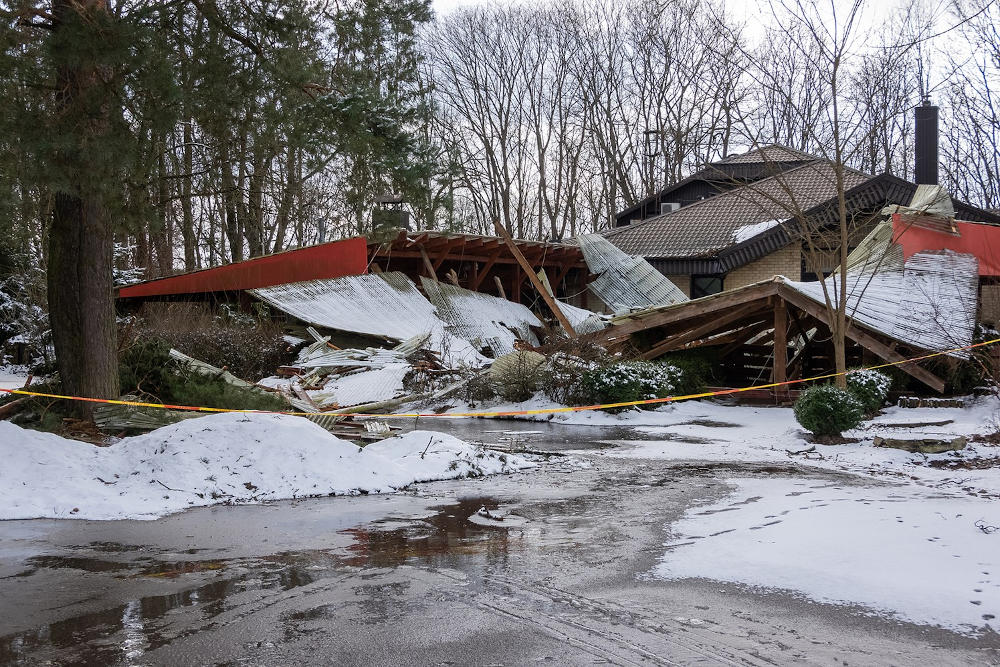
Your home is a huge investment worth protecting. Preventing property damage from winter weather should be a priority for homeowners. Rain, snow, ice, wind, freezing, flooding, fire – Mother Nature has many ways to cause problems. While you can’t control the weather, you can control how prepared your property is to safely weather the storm.
Cost of winter weather property damage
According to the Insurance Information Institute, 2021 winter storm damage caused over $1 billion dollars in insured property losses. This does not include uninsured property damage liability. It is important to read your homeowner’s insurance policy and understand what it does and does not cover if your property is damaged by weather. You may be surprised to see that it may not cover things like losses from landslides or erosion.
Property damage isn’t limited to physical damage to your home structure. Unfortunately, trees, plants, and other parts of your yard are often casualties. The ice storm of February 2021 alone caused the most tree damage of any storm event in the past 30 years!
Steps for preventing winter weather property damage
The good news is that your home and your yard don’t have to be casualties of winter weather. While you can’t stop hazardous weather from happening, you can prevent winter weather property damage with a little preparation:
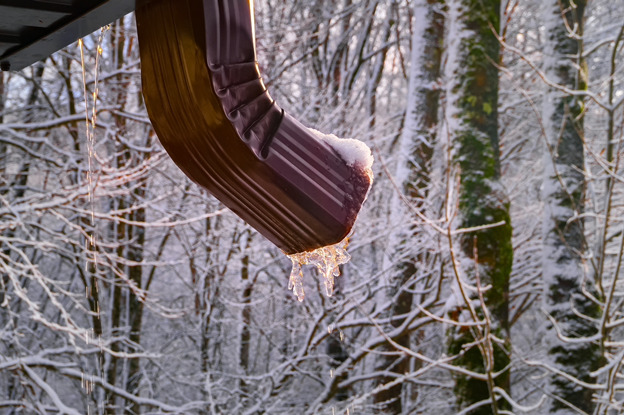
- Keep walkways and pathways clear. This goes for your driveway, sidewalk, and any areas of entry or exit around your home. Keep these free of any obstructions.
- Clean your gutters and downspouts. Make sure your gutters and downspouts are free from leaves and other debris so that water can easily flow off your roof and away from your house.
- Keep storm drains clear. During heavy rains, flooding can happen fast when water cannot properly drain from roadways. Keep an eye on this if you have a drain in front of your home.
- Don’t let snow and ice build up. Property damage is more likely to occur when snow and ice build up, not just from water but from weight. De-icer, a snow shovel or snow blower, and a roof snow rake to help with rooftop snow removal can all come in handy.
- Assess drainage and water pooling. Proper drainage is key to preventing flooding and water damage to your home. Sunken areas around your foundation or in your yard are high-risk for water accumulation. Drainage solutions like rain gardens or permeable pavers are not only effective, but can also add value to your property.
- Check for areas of erosion. Heavy rains can cause soil to wash away, increasing risk of flooding, landslides, and muddy messes. Installing retaining walls, culverts, or other landscaping features to aid with drainage can help prevent erosion.
- Trim and prune your trees. Remove dead, low-hanging, bowing, and damaged tree branches. Added weight from snow and ice is a recipe for broken branches and property damage. Cut back overgrown trees and plants that are too close to the house. Be sure to also check for high-risk branches overhanging your roof. Having a professional assess and prune your trees and plants is a worthwhile investment.
- Check for tree growth near power lines. NEVER remove these branches yourself. Contact your local power company about tree limbs that need to be pruned near power lines. Homeowners are generally responsible for trees growing near and around power lines. Power companies are responsible for trees touching or causing downed power lines. Removal of branches near power lines should be done by a tree trimming professional. The power company may shut off the power to the lines temporarily so pruning can be done safely.
- Winterize any outdoor spigots and irrigation elements. If indoor pipes are at risk of freezing, so are outdoor pipes. Make sure sprinkler lines and outdoor spigots are properly winterized.
- Secure anything at risk of becoming a projectile in high winds. This includes loose shingles, siding, fencing, lighting, and objects like lawn decorations, furniture, or swing sets. If you can’t nail it down or secure it into the ground, have a plan to store it when hazardous weather strikes.
Resources for dealing with weather-related property damage
In Washington:
In Oregon:
National:
Your home is a huge investment worth protecting. Keeping up on property maintenance is key to safeguarding your property against damage from hazardous weather.
For help with landscape and tree maintenance, property maintenance, residential or commercial cleanup, irrigation, erosion control and drainage solutions, contact us today!
 When the cold winter months arrive, your garden doesn’t have to become a dull, lifeless space. With a few simple additions, you can transform it into a winter wonderland and enjoy the outdoors even during the colder months. Here are some tips on adding winter interest to your garden and keeping your space looking beautiful all year round.
When the cold winter months arrive, your garden doesn’t have to become a dull, lifeless space. With a few simple additions, you can transform it into a winter wonderland and enjoy the outdoors even during the colder months. Here are some tips on adding winter interest to your garden and keeping your space looking beautiful all year round. Use winter-blooming flowers
Use winter-blooming flowers Best Types of Planters
Best Types of Planters 


 Incorporate Plants with Seeds and Berries
Incorporate Plants with Seeds and Berries Feed Birds
Feed Birds






